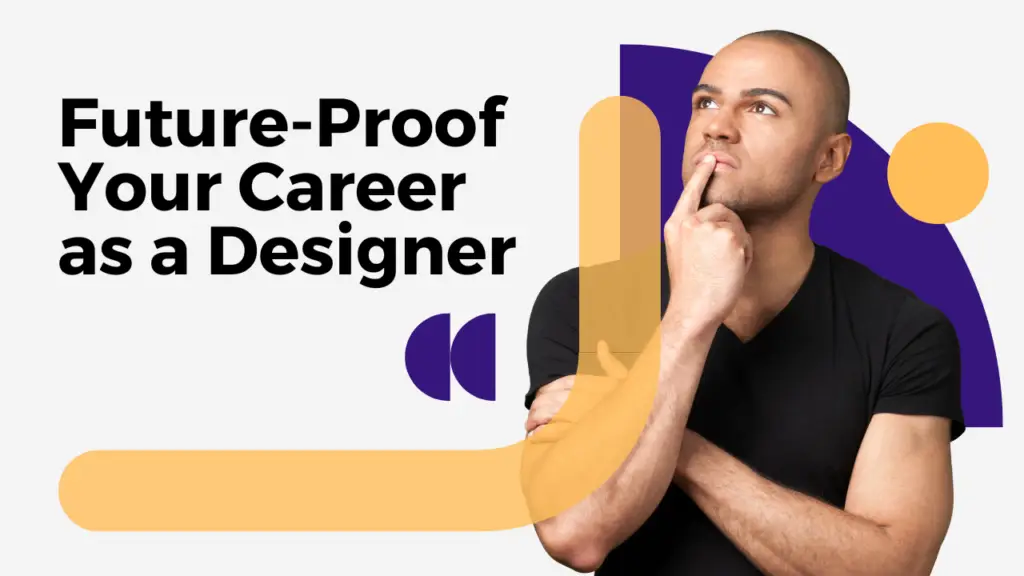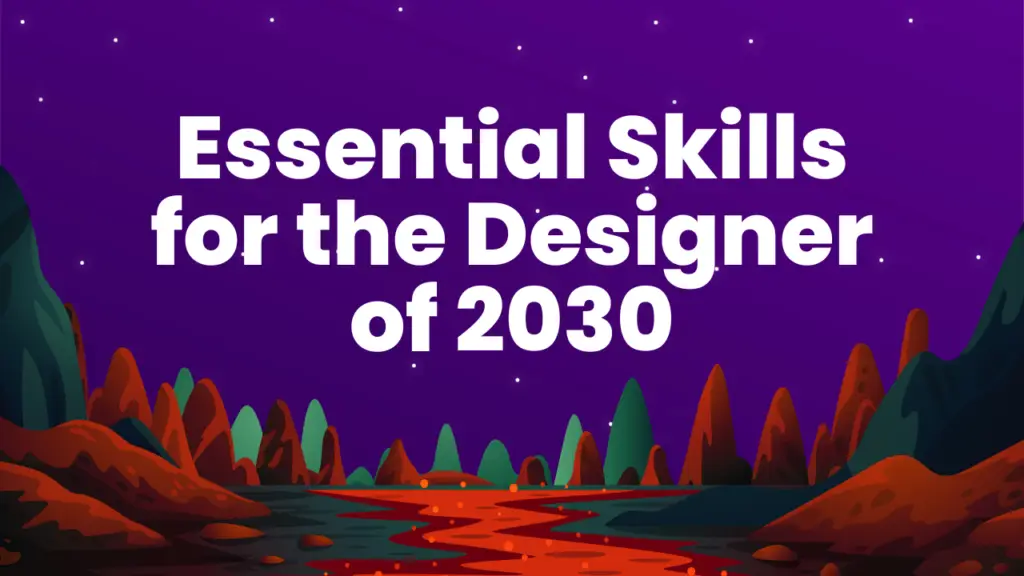Future-Proof Your Career as a Designer: Key Strategies
In today’s fast-changing world, designers must keep up to stay ahead. A recent study showed that 92% of design professionals think their skills need to change fast. This highlights the importance of being forward-thinking and strategic in your career.
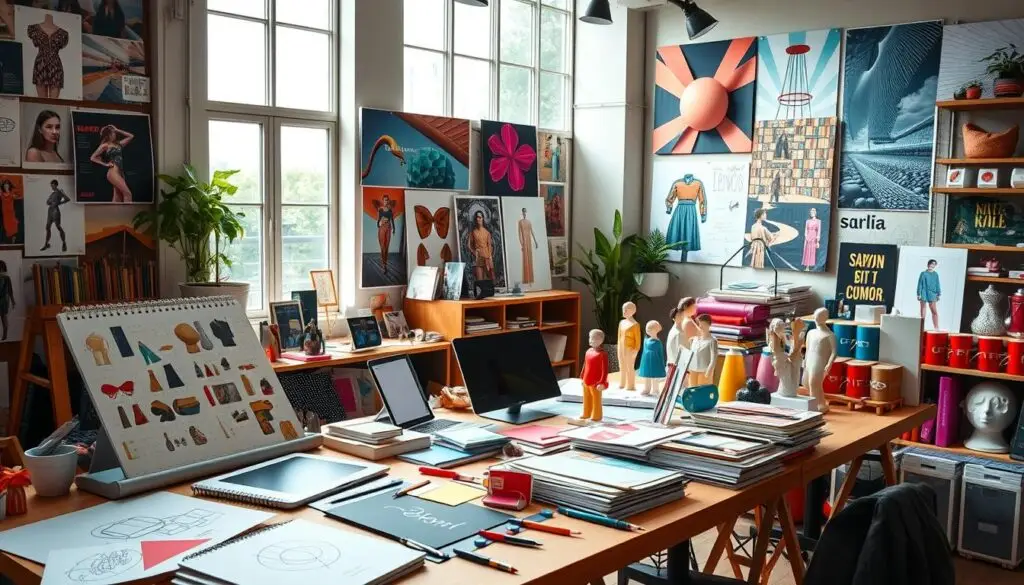
This article will give you the tools to future-proof your design career. By always learning, being adaptable, mastering design thinking, and keeping up with tech, you’ll stay relevant. Discover the key strategies to thrive in the ever-changing design world.
Embrace Lifelong Learning
In today’s fast-changing design world, lifelong learning is essential, not just a suggestion. Designers need to keep learning to keep their careers strong. They should update their skills, learn new design tools and software, and keep up with industry trends and technological advancements.
Continuous Education and Skill Development
Designers should always be learning. They can do this by going to workshops, taking online courses, or getting certifications. This way, they can keep their skills sharp and valuable to others.
Staying Abreast of Industry Trends and Technologies
- It’s key to watch industry trends and design technologies closely.
- Designers should look for updates in industry publications, blogs, and online groups.
- Learning about new software, tools, and methods can make designers stand out and offer better solutions.
By always learning, designers can make their careers last and be seen as important in the design world.
| Skill Development Strategies | Industry Trend Monitoring Techniques |
|---|---|
| Online courses and certifications Workshops and masterclasses Peer-to-peer learning Mentorship programs | Subscribing to design industry publications Participating in online design communities Attending industry events and conferences Networking with fellow designers |
Cultivate Adaptability and Versatility
In today’s fast-changing design world, career adaptability and versatile design skills are key. To keep your career strong, always be ready to learn and open to new chances.
Being adaptable means you’re open to learning new things and trying new areas. This flexibility helps you stay ahead and valuable in your field.
Building versatile design skills means knowing more than one area, like web design or motion graphics. This way, you can handle more projects and meet different client needs.
- Always be ready to learn new tools and techniques.
- Look into new design areas that fit with what you already know.
- Keep up with the latest trends and tech to find new design chances.
- Join online courses or design groups to grow your skills.
By being adaptable and versatile, you become a top choice for design jobs. You’ll be ready to take on new challenges and find exciting opportunities.
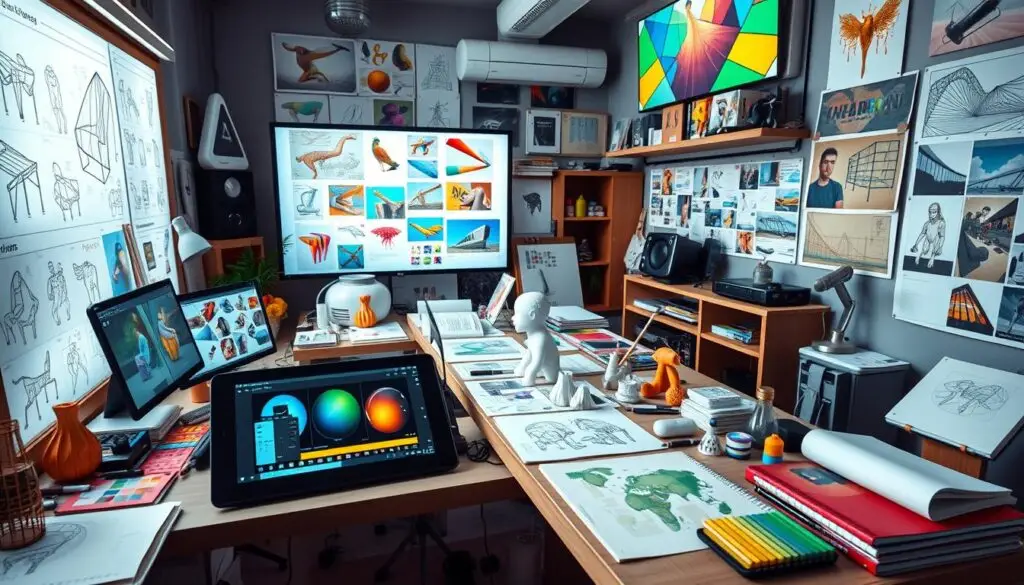
Master Design Thinking
Designers need to learn design thinking to keep up in their field. This method solves problems by using creative ideation and focusing on the user. It helps designers find new ways to solve complex issues.
Problem-Solving and Creative Ideation
Problem-solving and creative ideation are key in design thinking. Great designers can break down tough problems and find the root cause. They come up with many ideas to solve these problems.
This skill makes designers very valuable. They can lead to big changes and progress.
User-Centric Design Approach
A user-centric design approach is also vital. It puts the user’s needs first in the design process. Designers who do this well create solutions that users love.
This approach is key in today’s fast-changing world. It makes sure designs meet customer needs.
Learning design thinking helps designers become essential problem-solvers. They can innovate and keep their careers strong in the ever-changing design world.
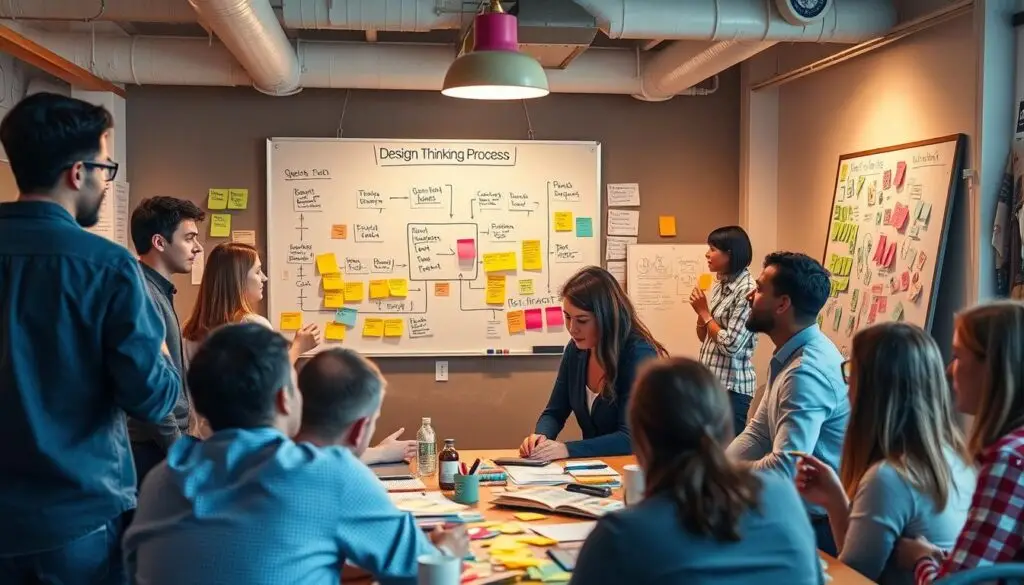
How to Future-Proof Your Career as a Designer
As a designer, it’s crucial to keep your career safe from changes in the industry. You can do this by learning new skills, staying up-to-date with trends, and planning for the future. Here are some important steps to take:
- Embrace Lifelong Learning – Always be learning and getting better at new things. Take online courses, go to workshops, and learn on your own. This will help you keep up with new technologies and design methods.
- Master Design Thinking – Improve your ability to solve problems and come up with new ideas. Use a design thinking approach that focuses on the user. This will help you meet changing customer needs and create innovative solutions.
- Develop Soft Skills – Work on your communication, teamwork, and leadership skills. These skills are important for working well in a changing design world and for working with different teams.
- Build a Strong Portfolio – Create a portfolio that shows off your design skills and problem-solving abilities. Keep it updated with your latest work and skills.
- Network and Engage with the Design Community – Go to design events, conferences, and meetups. This will help you meet other designers, learn from experts, and find new opportunities. Also, join online design communities to grow your network.
By following these steps, you can make your design career future-proof. Keep improving your skills, being adaptable, and staying involved in the design world. This will help you succeed in the ever-changing design industry.
| Key Strategies | Benefits |
|---|---|
| Embrace Lifelong Learning | Adapt to industry changes and expand design expertise |
| Master Design Thinking | Develop problem-solving and user-centric design skills |
| Develop Soft Skills | Enhance communication, collaboration, and leadership abilities |
| Build a Strong Portfolio | Showcase design versatility and problem-solving skills |
| Network and Engage with the Design Community | Stay connected, learn from experts, and explore new opportunities |
By using these strategies, designers can effectively how to future-proof your career as a designer and navigate the evolving landscape of design career strategies.
“The future belongs to those who learn more skills and combine them in creative ways.” – Robert Greene

Develop Soft Skills
Designers often focus on technical skills like design software and trends. But, employers want designers with strong design soft skills. These include communication, collaboration, leadership, and emotional intelligence. These skills help us manage complex projects, work well in teams, and add valuable insights.
Communication and Collaboration
Communication is key in design. Designers must share ideas clearly and listen well. They also need to work together effectively, sharing information and coordinating efforts.
Leadership and Emotional Intelligence
Leadership and emotional intelligence are also vital. Designers who lead and inspire their teams do better. Emotional intelligence helps designers manage their feelings and those of others, creating a positive work environment.
By focusing on these design soft skills, designers can improve their careers. They become more valuable in the job market and contribute more to their projects and teams.
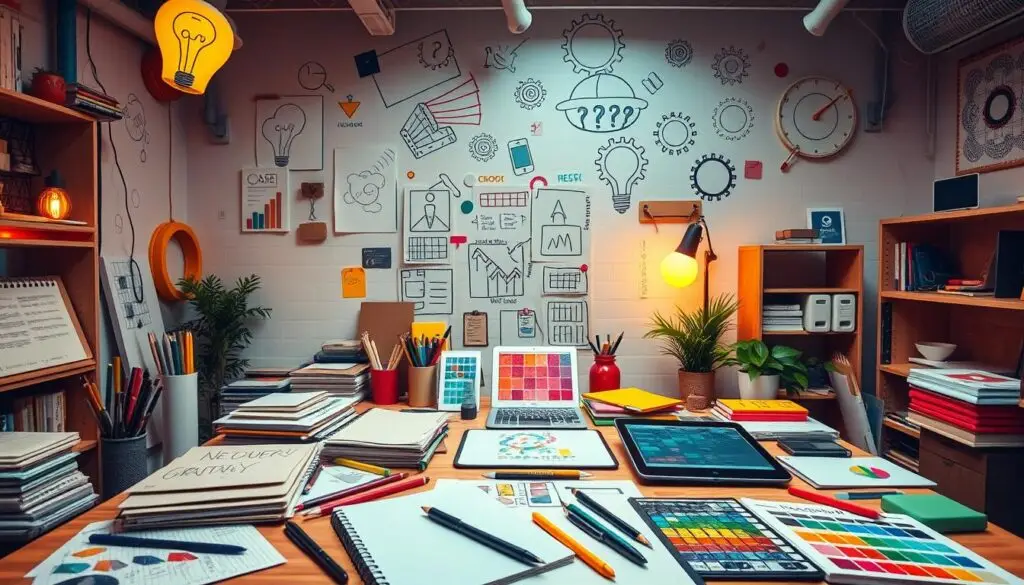
Build a Strong Portfolio
Your portfolio is like a business card for designers. It shows off your skills, creativity, and problem-solving. A good design portfolio is key to getting noticed in the job market and finding the right opportunities.
Keep your portfolio fresh with your latest work. This shows you can handle different design tasks. Your portfolio should show you can do branding, visual identity, and user interface design.
- Choose a variety of projects to show your design process and skills.
- Highlight your problem-solving by explaining the challenges and how you solved them.
- Make sure your portfolio looks good, is easy to use, and shows your design style.
Your portfolio should grow with you. Keep it updated to show your growth and adaptability as a designer.
“A great portfolio is not about quantity, but quality. It’s about showcasing your best work and demonstrating your design skills and problem-solving abilities.”
With a strong design portfolio, you can show your value and stand out. This opens doors for your professional development as a designer.
Network and Engage with the Design Community
Networking and engaging with the design community can boost a designer’s career. Going to industry events, design conferences, and local meetups is key. It helps designers keep up with trends, meet new people, and learn from pros. A strong network can lead to new chances and success in the long run.
Attending Industry Events and Conferences
Design networking events and conferences are full of benefits. They offer:
- Updates on the latest trends and tech
- Workshops and seminars for growth
- Chances to meet peers, mentors, and employers
- Opportunities to show your work and get feedback
- Shots at new jobs or projects
By diving into the design community, designers can stay ahead, learn more, and set themselves up for success.
“Networking is the single most powerful marketing tactic to grow a business. Your network is your net worth.”
– Porter Gale, Author and Entrepreneur
| Event | Location | Date |
|---|---|---|
| AIGA Design Conference | New York, NY | October 12-14, 2023 |
| Adobe MAX | Los Angeles, CA | November 2-4, 2023 |
| Design Week Portland | Portland, OR | April 16-21, 2024 |
Explore Specializations and Niche Markets
Designers looking to secure their future can consider specializing in certain areas. This could be in user experience (UX) design, motion graphics, or sustainable design. By focusing on a specific field, they can stand out and add more value to their work.
Choosing a niche that matches your interests and the industry’s needs can be transformative. It lets you develop a unique skill set. This makes you a leading expert in your design specialization. Spending time to become an expert in a field can lead to new opportunities and make you more noticeable in a competitive job market.
Being adaptable in your career is key in the changing design world. By always looking into niche markets and keeping up with new trends, designers can secure their careers. They become essential to their clients and employers.
| Design Specialization | Niche Market | Potential Benefits |
|---|---|---|
| User Experience (UX) Design | E-commerce and Retail | High demand for seamless and intuitive digital experiences |
| Motion Graphics | Social Media and Video Marketing | Increasing need for engaging and visually appealing content |
| Sustainable Design | Green Building and Environmental Products | Growing emphasis on eco-friendly and energy-efficient design solutions |
Exploring design specializations and niche markets helps designers secure their careers. It keeps them competitive and opens up new paths for growth and satisfaction.
Embrace Technological Advancements
As a designer, it’s key to keep up with the newest design technology, design software, and design tools. Learning new design apps, adopting digital workflows, and knowing about new tech keeps your skills sharp. This makes sure you’re ready for the changing design world.
Mastering Design Software and Tools
Staying ahead by learning and trying out design software and design tools can really help you stand out. Check out these top-notch technologies:
- Adobe Creative Cloud apps (Photoshop, Illustrator, InDesign, etc.)
- Figma, Sketch, and other UI/UX design platforms
- 3D modeling and animation tools like Blender and Maya
- New tech like virtual reality (VR) and augmented reality (AR) design tools
Knowing these design technologies well helps you meet the design industry’s ever-changing professional development needs.
| Design Software | Key Features | Potential Applications |
|---|---|---|
| Adobe Photoshop | Pixel-based image editing, layering, and compositing | Photo retouching, digital painting, web graphics |
| Figma | Vector-based UI/UX design, real-time collaboration | Wireframing, prototyping, interface design |
| Blender | 3D modeling, animation, rendering, and VFX | 3D asset creation, motion graphics, virtual environments |
“Mastering the latest design software and design tools is not just a nice-to-have, but a necessity for designers who want to future-proof their careers.”
Foster an Entrepreneurial Mindset
Designers in today’s job market can benefit from an entrepreneurial mindset. This mindset helps them solve problems, think innovatively, and adapt quickly. It also encourages them to start their own design entrepreneurship ventures or freelance.
Having an entrepreneurial mindset lets designers lead their careers. They can find new ways to make money, adapt to market changes, and take charge of their career adaptability. This approach makes them proactive, resourceful, and ready to take risks.
There are many ways to develop an entrepreneurial mindset:
- Develop a problem-solving and innovative approach to design challenges
- Explore starting a design-focused business or freelancing
- Stay updated on industry trends and technologies
- Network and collaborate with other designers and professionals
- Keep learning and upskilling to stay competitive
By adopting an entrepreneurial mindset, designers can ensure their long-term success. They can create their own career paths, even when the industry changes. This mindset is key to future-proofing a design career.
“The most successful people in the world are those who have an entrepreneurial mindset and are willing to take calculated risks to achieve their goals.” – Unknown
Conclusion
In this article, designers got a solid plan to keep their careers strong in the changing design world. They learned to always learn, be flexible, and use design thinking. They also found out how to improve their soft skills.
Designers can make a great portfolio, connect with others in design, and learn new tech. They can also think like entrepreneurs. This helps them stay ahead in the job market.
By using these strategies, designers can make sure their careers are secure for the future. They can grow and adapt, becoming key players in the design field. This way, they can succeed and keep their skills sharp.
FAQ
How can designers keep their skills relevant and in-demand in the ever-changing design industry?
Designers can keep up by always learning and updating their skills. They should stay current with trends and tech. This way, they stay valuable in the job market.
What role does adaptability and versatility play in a designer’s career longevity?
Adaptability and versatility are key for designers. They should be open to learning new things and exploring different areas. This helps them stay relevant and find new opportunities.
How can design thinking skills help designers future-proof their careers?
Designers who are good at design thinking are set for the future. They solve problems creatively and focus on the user. This makes them essential in design-driven teams.
What soft skills are important for designers to develop to future-proof their careers?
Employers value soft skills like communication, teamwork, and emotional intelligence. Designers with these skills can handle complex projects and work well with others. They add value to design efforts.
How can designers build a strong portfolio to showcase their versatility and adaptability?
A good portfolio is crucial for designers. It should show their latest work and versatility. A strong portfolio helps designers stand out and find the right opportunities.
What are the benefits of networking and engaging with the design community for future-proofing one’s career?
Networking is key for designers. It helps them learn about trends, meet people, and get insights. A strong network opens doors to new opportunities and success.
How can exploring specializations and niche markets help designers future-proof their careers?
Designers can specialize in areas like UX design or sustainable design. This makes them more valuable and sought-after. Finding a niche that interests them and meets industry needs helps them stand out.
Why is it crucial for designers to stay up-to-date with the latest design technologies and tools?
Designers need to know the latest design software and tech. This keeps their skills relevant and adaptable. Learning new tools gives designers an edge and opens doors to new opportunities.
How can cultivating an entrepreneurial mindset help designers future-proof their careers?
An entrepreneurial mindset is valuable for designers. It involves solving problems creatively and exploring business opportunities. This mindset helps designers navigate the job market and create their own paths.

